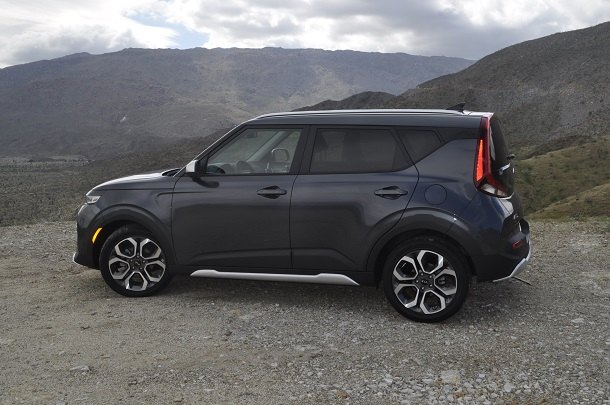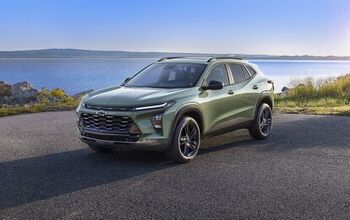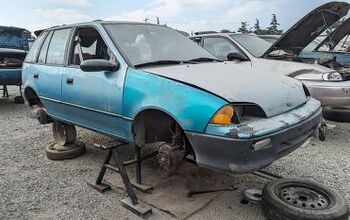2020 Kia Soul First Drive - Meeting Expectations Nicely

When you look at a Kia Soul, you likely peg it for just what it is – a boxy, utilitarian commuter vehicle. You wouldn’t expect it to be a blast to drive, or full of coddling luxury materials and content.
Sometimes, what you see really is more or less what you get. This is one of those cases, with some pleasant surprises along the way.
The updated Soul has new exterior duds, a re-imagined cabin, and a newly available turbo mill.
Kia is making the Soul available in seven trims (LX, X-Line, S, EX, EX Designer Collection, GT-Line 2.0L, and GT-Line 1.6T), and they gave us the keys to an X-Line and a GT-Line during our first drive.
(Full disclosure: Kia flew journalists to San Diego, put us in a nice hotel, asked us to wear a music-related T-shirt to dinner, and fed us. They offered to make a custom T-shirt; I did not take them up on the offer).
The reason those two trims were the only Souls on hand? Kia believes they will be the two best-selling trims. An electric version of the Soul will also be available, but that launch is scheduled for later this year.
My day started in the X-Line, with the 2.0-liter direct-injection four-cylinder from the Kia Forte – dubbed Nu in Kia-speak – underhood. The specs sound weak – just 147 horsepower and 132 lb-ft of torque. But while a little more oomph would be nice for passing, it’s otherwise plenty fine for commuting duty. The biggest issue with this motor is refinement – it’s buzzy and loud.
The continuously-variable automatic transmission it pairs with is called Intelligent Variable Transmission by Kia. Whatever you call it, it has six ratios and the feel of a normal “step” transmission (read: conventional automatic), and it’s a tad slow to downshift. It does seem to hold on to the lower gears in Sport mode, though.
Kia dialed in nice heft to the steering, in both Sport and Normal drive modes, although feel is a bit artificial. The result is a car that’s pretty engaging to drive, if not a sleeper compact sport hatch.
That steering feel mostly carries over to the turbocharged GT-Line car, but the GT felt a little more buttoned-down in corners. Body roll is present on both cars, which isn’t surprising given the boxy roofline, and there’s a bit of understeer when you push.
The 1.6-liter turbo four makes 201 horsepower and 195 lb-ft of torque, and the additional power is welcome. This motor is also smoother than the 2.0, making it the preferred choice. While the Soul is a pretty good utility compact with the 2.0, it’s a much better car with the turbo.
Kia did miss an opportunity – the 1.6 turbo is only available with a seven-speed dual-clutch automatic. Like the CVT in the base car, it too holds on to gears in Sport mode (Sport mode in both cars seemed to change throttle and transmission inputs more than steering). That’s not the missed opportunity, though – this car could be a real hoot to drive with a manual transmission. A six-speed stick is offered in the base trim only.
Ride quality on mostly smooth California roads is generally good, and even rougher stretches of pavement don’t disturb much. But road and wind noise was an issue in both trims, in addition to the X-Line’s engine noise.
Leg and headroom are aplenty up front, and the seats are comfy enough for a day’s driving. The X-Line is short on some content – no XM, really? – and both cars have soft-touch dashes marred by hard plastic along the bottom half.
I like the ovoid shape that surrounds the audio/infotainment system and the cool design touches along the top and front of the front doors, just ahead of the door handles. It’s a functional cabin with flair.
I’m also a fan of the overall look. It’s evolution over revolution – the shape remains unmistakable. But I like the larger grille, the horizontal light bar across the front, and the wraparound taillamps.
Both the GT-Line and X-Line have visual cues that set them apart from the rest of the line. For the X-Line, that means overfenders, body cladding, accents along the roof rail, fog lamps, 18-inch wheels, and available two-tone paint.
The GT is set apart by different front and rear fascias, 18-inch wheels, red accents on the front fascia and side sills, fog lamps integrated into the front grille, black side mirrors, D-shaped steering wheel, special badging, chrome center dual exhaust finisher (not a true dual exhaust), bigger brakes, and sport-tuned suspension.
The Soul gains a bit over an inch of wheelbase length and is 2.2 inches longer. Front legroom is up a tiny bit, and cargo space is up 5 cubic feet to 23.8. Speaking of cargo, the liftgate moves up quickly – watch your head.
Key available content includes Android Auto, Apple CarPlay, a 10.25-inch infotainment screen, two-device Bluetooth connection, eight-inch head-up display, sunroof, dual-zone climate control, heated seats, heated steering wheel, push-button start, satellite radio, tilt and telescope steering wheel, USB, and 640-watt premium audio system with amplifier and 10 speakers.
Available safety ninnies and nannies include forward-collision avoidance, lane-keep assist, lane-change assist, driver-attention warning, blind-spot collision warning, rear-cross collision warning, smart cruise control, and high-beam assist.
Pricing is as follows: A manual-transmission Soul LX will cost you $17,490, and an LX automatic will pop you for $18,990. An S goes for $20,290, and so does a GT-Line with the 2.0-liter four-cylinder. An X-Line checks in at $21,490, and an EX at $22,690. Opt for the GT-Line with the 1.6-liter turbo four and you’ll have to pony up a decent chunk of change: That car is priced at $27,490. All trims have a $995 destination fee.
Fuel-economy is listed at 27 mpg city/33 mpg highway/30 mpg combined for the 2.0-liter with IVT, 25/31/27 for the stick, and 27/32/29 for the turbo.
The end result of Kia’s changes to the Soul is a pleasant commuter car with just enough sportiness (especially in turbo models) to avoid being boring. Boxy styling isn’t for everyone, but for those looking for an affordable around-town grocery-getter that can also ferry you to work without putting you to sleep, the Soul is worth a look.
Also, if Kia/Hyundai continues to insist on reminding us that Albert Biermann works there now, maybe they can sic him on a new project – a hopped-up performance version of the Soul. That would make me take notice.
As well as perhaps exceed my expectations.
[Images © 2019 Tim Healey/TTAC, Kia]

Tim Healey grew up around the auto-parts business and has always had a love for cars — his parents joke his first word was “‘Vette”. Despite this, he wanted to pursue a career in sports writing but he ended up falling semi-accidentally into the automotive-journalism industry, first at Consumer Guide Automotive and later at Web2Carz.com. He also worked as an industry analyst at Mintel Group and freelanced for About.com, CarFax, Vehix.com, High Gear Media, Torque News, FutureCar.com, Cars.com, among others, and of course Vertical Scope sites such as AutoGuide.com, Off-Road.com, and HybridCars.com. He’s an urbanite and as such, doesn’t need a daily driver, but if he had one, it would be compact, sporty, and have a manual transmission.
More by Tim Healey
Latest Car Reviews
Read moreLatest Product Reviews
Read moreRecent Comments
- Offbeat Oddity The price is definitely too high, but this generation of Accord has still been very reliable- not far off from the Camry. I believe the CVTs in these have held up very well, so while not ideal, it wouldn't deter me- the mileage is just way too high.
- VoGhost "compliance EVs" - so typically Posky. Come on, Matt, come clean about what Big Oil is paying you already.
- VoGhost Great to see leadership from Washington in supporting American businesses and job creation.
- VoGhost Oh, Mattie, I am BEGGING you to take a course in economics. There's probably a community college near you offering courses for free or very cheap. Seriously, people this ignorant of basic economics really should not be writing this drivel. Stick to what you know: pimping for big oil.
- 2manyvettes I was a computer instructor in a local technical college for some years teaching Windows OS and Micosoft Office. Not long before I retired I purchased a Mac Book Air laptop. It didn't take me long to learn the Apple OS and the first thing I learned was the lousy job Microsoft did ripping off the Apple software. I purchased Microsoft Office for Apple at the time and discovered when Apple upgraded the OS to 64 bit and my 32 bit Office software would no longer run on the laptop, that embedded in the Apple OS was software that could open any Office file and could save any file in Microsoft file format. I have always felt if Apple sold product at PC prices they would put Microsoft out of business. Oh, and I bought my Mac ten years ago and still runs like brand new. Effect on Rivian? Who knows? Based on my experience with their technology, it could be interesting.








































Comments
Join the conversation
Ugh. That massive wraparound taillight looks terrible.
So, they really CAN integrate the screen into the dash so it looks like it belongs there.